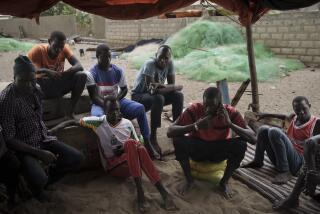Away from the madding Brazilian crowd
- Share via
SÃO MIGUEL DOS MILAGRES, Brazil — Anyone who says it’s the journey that matters most wasn’t trying to navigate through the favelas of Maceió, my launch point for Brazil’s Costa dos Corais, or Coral Coast, 50 miles north.
Although Maceió has a reputation for crime, the real threat occurred when my GPS had me turn onto Avenida Presidente Roosevelt. Suddenly, I was facing three lanes of traffic heading directly toward me.
“What do I do now?” I asked my partner, Chris, who calmly replied, “Just keep going.”
Our Fiat rental was small enough to squeeze onto the bike lane — a maneuver that barely fazed the cyclist I almost clipped. And I succeeded in driving a good half-mile with not a single motorist honking. Try doing that in L.A.
With Pope Francis’ recent visit, which drew exuberant crowds numbering in the millions, and the upcoming World Cup and the Summer Olympics, Brazil has now elbowed its way onto the world’s radar screen.
However, Chris and I were seeking tranquillity and empty beaches on our two-part trip.
On this late December day, we were headed to Pousada da Amendoeira, a boutique inn a world away from the shanty towns and sugar plantations we would pass on the way to São Miguel dos Milagres.
It was an uneventful three hours by the time we made that final turn for the beach. Soon we were sipping agua de coco under a canopy of thick green leaves.
“This is the Amendoeira tree — which we used to name the inn,” said Tsachi Greenhut, an Israeli transplant. He and his Brazilian wife, Jessy, opened the pousada five years ago. “Getting to know the local people, who received us with authentic smiles, has taught us a great deal about nature,” Jessy said, “and how to lead a simple life without the stress and overconsumption of big cities.”
Amendoeira, which abuts the largest protected marine reserve in the country, is big on sustainability; hence the solar panels, composting, organic vegetables and participation in environmental projects.
This is laid-back Brazil, being, as it is, more than 1,000 miles away (a 2 1/2-hour flight) from Rio’s all-night samba clubs. Amendoeira has capitalized on that vibe, thanks to its mellow yet attentive staff, abundance of hammocks, hot tubs and healthful aesthetic enhanced by locally influenced fusion cuisine.
Yet Amendoeira is small enough to feel intimate. Eight bungalows are set amid a plush green carpet and fragrant flowering plants; most are just a few steps from the shaded deck overlooking the ocean.
For all the pousada’s comforts, it’s the vast expanse of calm transparent water that is the main attraction. That’s why Chris and I were on the sand in time for the 5 a.m. sunrise on four of the five mornings we spent here. This schedule helped prime us for the snorkeling/manatee viewing excursion that we planned for 7 a.m. on our third day.
Of course, this is South America, so it was closer to 8 o’clock when we began the half-mile walk through the knee-deep water to meet the jangada, a narrow, flattish wooden boat built for the baby waves.
“Tudo bem?” (“Everything OK?”), Israel, the jangadeiro, called out as we stepped onto the boat for the five-minute trip to the tidal pools. We were forced to rely on our hastily learned Portuguese, but we didn’t need anyone to translate the fact that we were drifting through an azure bathtub with huge stands of coconut palms fringing the shoreline.
The snorkeling didn’t compare to the Great Barrier Reef’s, but there is something sublime about swimming in perfectly clear 82-degree water on a late December morning.
The highlight of the trip began with our getting stuck on a beautiful sandbar and waiting for the tide to rise so the boat could enter the Tatuamunha River, home to the sanctuary for the country’s most endangered aquatic mammal, the manatee, or peixe-boi as locals call it. Since 2006, the Program for the Reintroduction of Peixes-bois Marinhos has been educating locals and tourists about the importance of conserving these creatures that were nearly hunted to extinction.
“Não toque!” (“Don’t touch!”), Israel told us as we entered the preserve, but a few minutes later, a manatee nuzzled my foot after lifting its flipper onto the boat. These guys may weigh 1,200 pounds, but they’re friendly. Rather than swim away from us, the peixe-bois approached the boat as we drifted along the mangrove-lined riverbank.
When we returned to the open water, the sea was finally starting to rise, but the 2-foot swell was just a faint precursor to the more dynamic phase of our trip — exploring Morro de São Paulo on the Bahian island of Tinharé.
Getting there had us retracing our tire treads back to Maceió — this time, driving with the traffic on Avenida Presidente Roosevelt and catching a one-hour flight to Salvador, where we would take a catamaran to Morro de São Paulo the next day.
If you find yourself in Bahia’s capital with a few hours to explore, just follow this three-part formula: Pelhourinho + Moqueca de Camarão + Balé Folclórico da Bahia. Pelhourinho is the neighborhood you’ll visit and sleep in; moqueca, the regional specialty made with coconut milk, cilantro, shrimp and spicy malagueta peppers, is what you’ll eat; and the Balé Folclórico, a 38-member troupe of dancers, musicians and capoeira performers, is the most scintillating hour and the best 35 reais (about $17) you’ll spend in Brazil.
Indeed, as the catamaran made the 21/2-hour trip through calmer-than-normal waters, I kept returning to images of the fire dancers and capoeira acrobats backflipping across the stage.
My concerns about a travel blog comment — “If there are even the tiniest of waves on the ocean do not, I repeat, do not take the catamaran between Salvador and Morro de São Paulo!” — didn’t materialize, and soon we were sifting through the suitcases stored chaotically in the front of the boat.
The first thing you notice on arrival, apart from the hills — morro means “hill” in Portuguese — is the lineup of wheelbarrows, the mode of transportation, at least for luggage, because there are few cars in Morro. And if you happen to arrive during the run-up to New Year’s Eve, as we did, you’ll see why the place is known as party central.
Our goal, however, was to continue relaxing and snorkeling. That’s why we chose the highest pousada on the island. “There’s Colibri,” Claudio, who came to carry the bags, said, pointing upward. When I glanced at his cart holding our belongings, I was relieved someone else would be pushing the “vehicle” up the 45-degree inclines, dirt paths and the final 155 steps in the 90-degree heat.
When Marga Bendel-Bauer greeted us at the summit in her German-accented Portuguese, I realized we had ended up in an oddly tropical German paradise. The views were stunning, and the morning bread and cake abundant — if that’s what you’re into — but mostly we had a tranquil refuge from the all-night raves below.
It’s a 10-minute stroll to the village’s carless central plaza, with its blue and white colonial church, hotels and cafes. This leads to the main drag, Broadway, with more restaurants, bars and shops to buy Havaiana flip-flops, apparently the footwear of choice. Seafood dominates the cuisine, but it’s not a foodie’s destination, which may be why they invented caipirinhas. After just one, you’ll stop caring that fish is overcooked and the pasta is mushy.
The concrete eventually morphs to sand leading to the four main beaches named, unceremoniously, First, Second, Third and Fourth. Most of the action centered on Segunda, where numerous hotels, snack bars and restaurants with live music extend well onto the sand.
It’s also ground zero for the never-ending parade of sunga-clad men and women in their biquíni fio dental (“Fio dental?” Yes, “dental floss.”). Terceira mellows a bit, but it’s at Quarta, the longest and quietest stretch of sand, that things calm down — though I was drawn to the triangle of beach between Third and Fourth, thanks to its snorkeling spot where I spied an electric blue fish.
If you crave fewer Brazilian tourists (few Americans venture here), you can join one of the many boat excursions to Ilha de Boipeba with its miles of pristine beaches, coral reefs, salt marshes and mangroves.
Our 45-minute speedboat jaunt had us ricocheting against 8-foot waves and joining a flotilla with about 100 snorkelers captivated less by tropical fish than by beer bottles balanced on floating food trays.
Soon though, we were dropped off at windswept Boca da Barra beach near the river that promised (and delivered) a much calmer route back. The only thing lacking was time. With just a couple of hours to explore the vast stretches of powdery sand and shady trails through the rain forest, our visit was mostly a paradise tease.
We thought of spending the night, but then we would have missed Morro’s Réveillon — or New Year’s Eve. Americans obsessively watch a ball drop on TV or freeze in Times Square; Brazilians throw flowers into the ocean and jump the waves for a dose of good luck and enlightenment.
Standing with our feet in the warm water as the countdown began, fireworks exploding overhead, there was not a sunga or bikini to be seen — just a throng of Brazilians clad in white to purify their souls for the coming year.
More to Read
Sign up for The Wild
We’ll help you find the best places to hike, bike and run, as well as the perfect silent spots for meditation and yoga.
You may occasionally receive promotional content from the Los Angeles Times.






